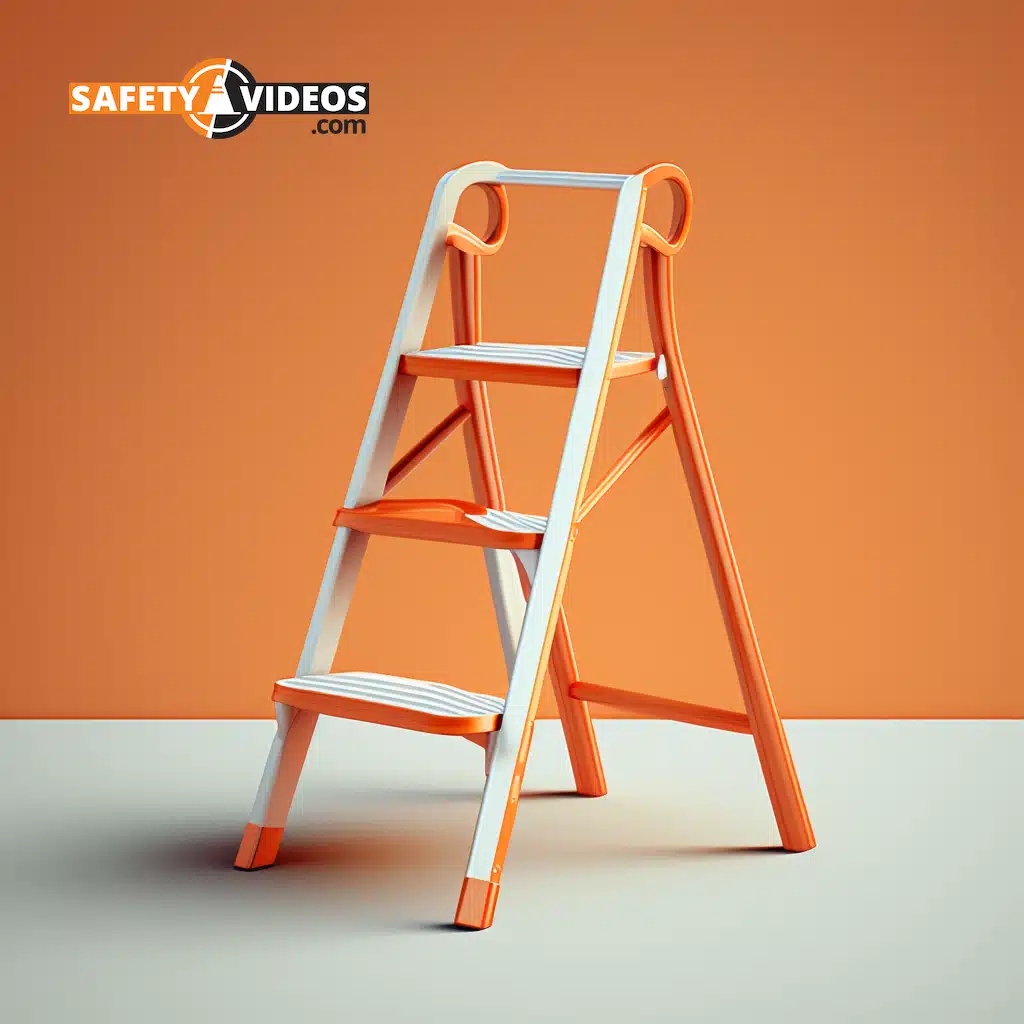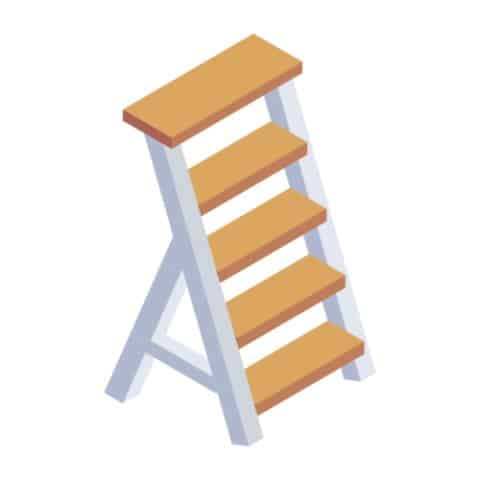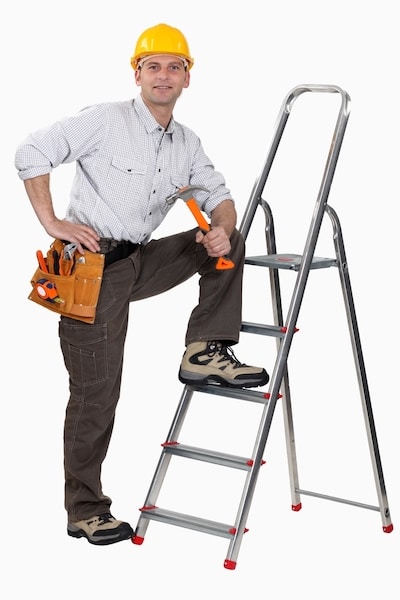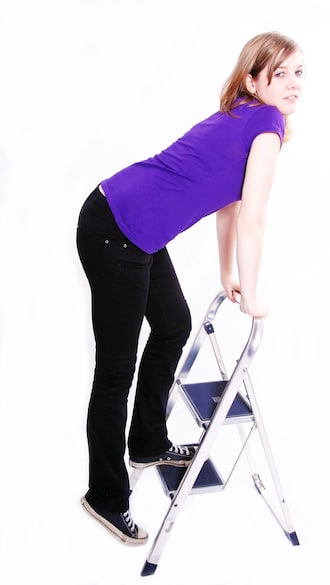How To Safely Use a Step Ladder: Essential Tips and Best Practices

How do you get up there to change a light bulb or paint a wall? Simple; use a step ladder. However, great responsibility comes with great convenience.
Here, we will review stepladder safety, explore the various types of step ladders available, learn to choose the right one for your needs, and, most importantly, learn how to use it safely. This is an excellent complement to our complete ladder training program.
So let’s climb up the rungs of knowledge and reach new heights of OSHA step ladder safety awareness!
Step Ladder Safety Tips
A stepladder is a type of ladder that’s easy to transport thanks to its small, portable, and self-supporting design. These ladders are shaped like an A-frame and have flat steps, bracing, and two front and rear side rails.
Stepladders range in size; some models reach up to 20 feet, while others are smaller. Those stepladders shorter than 4 feet are typically called step stools and are easily foldable for quick storage. However, MOST step ladders are just a few feet high at most.
The highest rung you can stand on is marked on the product’s specifications label and is slightly more than two feet from the top of the ladder.

Which Is a Correct Way To Use Step Ladders?
If you want to know how to avoid ladder accidents, you’ve come to the right place. Whether you’re a professional or a DIY enthusiast, it’s essential to understand the hazards associated with stepladders and how to avoid them.
Do You Have the Right Ladder?
Use a ladder that can support at least four times the desired load as a general guideline. And remember to include the weight of all tools, equipment, and other materials you plan to carry around to help ensure you stay within the load rating.
Consider the type of work you’ll be doing and the altitude you’ll be working at. For shorter heights, step stools may be a good option. For taller heights, you may need an extension ladder.
There are also specific material types of ladders, such as heavy-duty or rugged and medium-duty commercial ladders.
Important Step Ladder Safety Tip: Inspect and Review
First, read the instructions and labels provided by the manufacturer. This information can provide valuable insights into adequately using and maintaining the ladder.
Remember, safety should always come first, so take the time to inspect the ladder before using it and follow these guidelines.
When you conduct an inspection, look for any signs of structural damage, such as:
- Split or bent rails
- Broken or missing rungs or steps
- Missing or damaged safety features
- Grease, dirt, and other contaminants
Additionally, remove any paint or stickers (excluding warning or safety labels) that may cover up potential defects.

What Should You Not Do on a Step Ladder?
- Don’t use a stepladder as an extension ladder.
- Don’t use cross bracing on the rear for climbing.
- Don’t step from one ladder to the other.
- Don’t skip a tool belt if you need to carry tools or equipment while climbing.
What Are 10 Other Safety Rules for Using a Ladder?
Here are some common hazards you should be aware of and tips to mitigate them to ensure the proper use of step ladders.
1. Damaged Stepladder
A damaged stepladder can be unstable and pose a risk of falling. Before using a stepladder, inspect it thoroughly to ensure it’s in good condition and free of any cracks or broken parts.
2. Step Ladders on Slippery Surfaces
Make sure the ladder’s base is on a stable and level surface. Additionally, ensure the ladder’s steps and rails are free of any slippery materials that could cause a slip. If using a stepladder on slippery or unstable bases, consider using a slip-resistant mat or applying anti-slip tape to the legs.
Maintaining a firm hold when climbing is critical, especially in slippery or wet weather conditions.
3. Step Ladders on an Uneven Base
Place on a level ground support to ensure stepladder safety. Don’t place it on boxes, barrels, soft ground, unstable bases, or other objects. And don’t move or shift the ladder while someone is on it.
4. Sideways Motion
Avoid performing a sideways motion when using a stepladder. Instead, stand directly before the ladder and hold onto the side rails for stability. Also, keep your center of gravity near the middle, and face the ladder while climbing to ensure stability.
5. Unlocked Ladder Spreaders
The spreaders on the stepladder help keep the ladder’s sides parallel and prevent it from collapsing. Always make sure to lock the spreaders before using a stepladder.
6. Standing on the Top Step or Top Cap
Stepladders support weight only up to a certain height, typically the second step from the top. Please don’t stand on the top two rungs of a stepladder or the top cap, as it can cause the ladder to tip over and result in injury.
7. Loading the Step Ladder Beyond the Rated Load
Stepladders have a weight limit that you should not exceed. Loading a ladder with too much weight can cause it to break or tip over.
8. Step Ladders in High-Traffic Locations
Stepladders should be far from high-traffic areas where they could get knocked over or damaged by other people or objects. A barricade around the ladder’s base is also recommended to keep traffic away.
9. Reaching Outside the Ladder Side Rail
Always keep your body within the ladder’s rails when reaching for something. Going outside the rails can cause the ladder to tip over and result in a fall. When climbing a ladder, maintain three points of contact — two hands and one foot or two feet and one hand. It will help you maintain your balance and prevent slipping.
10. Step Ladders Near Electrical Wiring/Equipment
Metal ladders should never be in areas where they could come into contact with electrical wiring or equipment. It can pose a severe risk of electrical hazards. So, before handling or climbing the ladder, please check for overhead power lines so everyone can get home safely.

Recap: What Are 4 Ways To Use a Step Ladder Safely?
The most important things to remember are:
- Step ladder load and capacity
- Types of step ladders
- Understanding safety guidelines
- Reviewing manual instructions
How to Safely Use a Step Ladder: Final Thoughts
Following OSHA safety guidelines is a requirement for professionals for a reason. Your safety is always your top priority – Carelessness costs lives.
Instead, take the necessary steps and invest; it’ll pay off in the long run. After all, it’s always better to be safe than sorry.